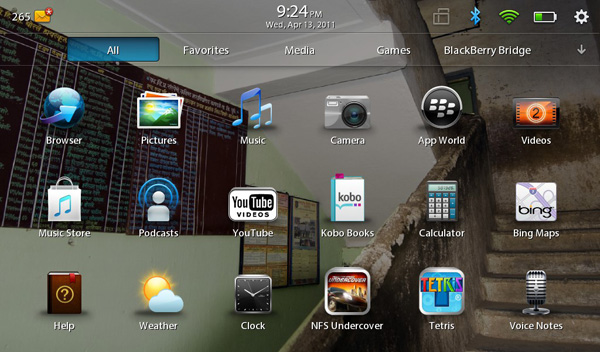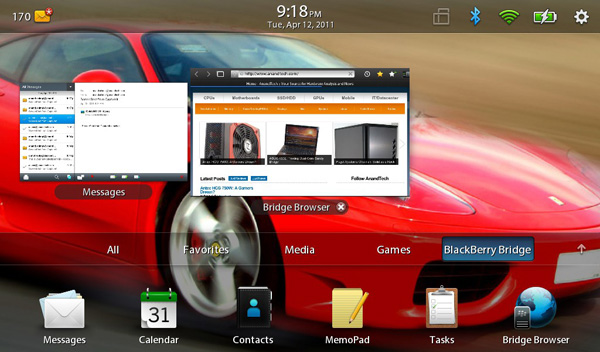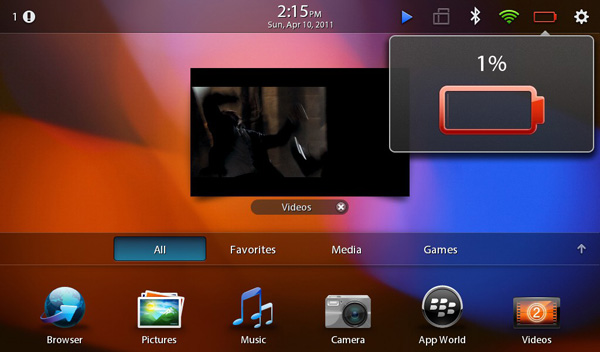The BlackBerry PlayBook Review
by Anand Lal Shimpi on April 13, 2011 9:00 PM EST- Posted in
- Tablets
- Smartphones
- RIM
- BlackBerry
- PlayBook
- Mobile
A New Home
Like many things, when talking about home screens there's a spectrum of options. On the simplest end we've got Apple with iOS, and for the ultimate in complexity there's a full blown desktop OS like Windows or OS X. In between there's Android and somewhere between iOS and Android we have the PlayBook OS.
The default home screen is your typical grid of apps. You can collapse the grid down to a single row of six icons in landscape mode, or view the full grid. RIM provides five tabs to help sort through apps: All, Favorites, Media, Games and BlackBerry Bridge (the latter only appears if you have Bridge enabled).
There's no support for folders, although you can rearrange icons and uninstall apps directly from the home screen the same way you would under iOS.
App launches are unfortunately a bit high latency. Select an app and you'll first see it launch as a thumbnail, then zoom in and finally run full screen. The whole process takes a couple of seconds but it feels longer than firing up similar iOS or Honeycomb apps.
Above the app grid is the multitasking UI, although you need to have at least one active app to see it in action:
Multitasking is smooth and well executed on the PlayBook. To switch between active apps just swipe left to right (starting from the left or right bezel, inner-screen swipes are application specific). You can also swipe up from the bottom bezel (the unlock gesture) while you're in an app to bring up a horizontal list of thumbnails of currently running apps. When in this thumbnail view you can swipe left to right to scroll through the list of apps, flick up (or hit the x) to quit apps and tap on a thumbnail to select and switch to an app. It's all clearly very webOS inspired, although I will say that webOS still feels a bit better in this regard.
Apps continue to run while you're deciding what to switch to. For example, if you're playing a video the player thumbnail will continue to animate while you select your next app. Only once you've selected that app will the video player pause.
RIM also gives you the option to control how background apps behave. By default background apps are paused once you switch away from them, however you can set them to keep running all the time or pause immediately upon activating the task switcher.
Scrolling through running apps is (for the most part) very smooth, with the UI running at 60 fps. The multitasking UI is extremely well done and honestly one of the most impressive parts of the PlayBook experience.
Notifications
With no email or calendar apps, the PlayBook doesn't have a whole lot to notify you of. Presently the only notifications the PlayBook will deliver have to do with remaining battery capacity.
Notifications on the PlayBook work by coloring a corner of the screen (I've seen this happen in both the upper left and upper right corners) if you're in a full screen app. Use the peek gesture to reveal the status bar and you'll see a little icon representing the app that spawned the notification. As I just mentioned, the only notifications that exist today are from the OS telling you that your battery is low but ultimately you'll see notifications from other first and third party apps here.
PlayBook's notification system is clearly a work in progress. Currently if you're charging a fully discharged PlayBook you'll get a notification every 1% between 0 and 6% telling you that the battery is low as you charge it. Also the only notification color supported today is red, which works well for "hey you're running out of battery life!" but not so well for "hey you just got 3 emails".
The notification system on the PlayBook has the potential to be decent. I expect that RIM will tweak the notification system over the coming months to accommodate other applications and services using it. The foundation is solid and RIM seems to be listening to feedback so I have hope for this working well.
There's also a notification LED on the front of the PlayBook, to the left of the front-facing camera. Today all it does is glow red when you turn on the PlayBook, but you can eventually expect it to have more BlackBerry-like functionality as RIM rolls out other things that can notify you (think emails).














77 Comments
View All Comments
PeeluckyDuckee - Thursday, April 14, 2011 - link
The Android platform UI is very unpleasant to work with and an eye sore, looks like something from yesteryears. The hardware supporting it is slow and lag is quite apparent, whether that is a software or hardware issue doesn't matter as in the end the user experience leaves a bitter taste in my mouth.Apps is a non issue imo as time goes on it will slowly come. The major titles will be available cross platform. I buy it for what it offers me now, I don't rely solely on what will come later.
The QNX UI is very smooth and true multitasking is available. 7" form factor is perfect for my needs. Battery life is less of an issue as it will be rarely transported, but if I do need it for extended periods outside of the house it'll be either plugged into the car charger, into my USB battery pack, or plugged into the USB charger in the plane.
5" is too small and 12" is too big for me, so I will eventually have the best of both worlds and juggle between the 7" Playbook and the 10" iPad 2. Both are priced cheap enough that it doesn't have to be mutually exclusive, considering how much laptops/desktops/tablets used to cost it's a no brainer.
bplewis24 - Thursday, April 14, 2011 - link
If you expected anybody to read your post, you shouldn't have destroyed your credibility with your opening sentence.Stuka87 - Thursday, April 14, 2011 - link
It seems like many of the Tablets (and even phones in some cases) these days are being rushed out. I can understand the rush to get a product to market to try and grab market share early before competing products get to well entrenched, but coming out with a product that is short of features seems like it could be just as bad.Take WP7 for instance, in general it has some good concepts, but is missing a lot of features, as well as a usable browser. Updates will fix this, but the initial reviews have hurt it I think.
Then you have Android 3.0 which only works on Tablets, and has issues with them as it is. It was definitely rushed out to try and grab some market share before Apple gets much more entrenched.
Then we have this device, which has some cool features, but many features that will not be available until sometime this summer.
I realize the companies have to found a balance between getting a product out and finishing it, but it seems in some cases its cut too close. And we end up with a product that could have been great if only it had spent a bit more time in development.
On a side note, I do NOT like the screen on this device. Its way to narrow. I would not enjoy having a screen with that aspect ratio.
xype - Thursday, April 14, 2011 - link
"It seems like many of the Tablets (and even phones in some cases) these days are being rushed out."Just shows how much of a lead Apple actually has with the iPad. Most of the stuff out by now can't even compete with iPad 1, much less 2.
And even _when_ they get some small details right, it's the overall experience that makes the iPad's competition suffer.
Also, I quite like iPad's 4-finger-gestures for multitasking—too bad you have to set up your iPad as a development device to activate the preference in the first place…
medi01 - Thursday, April 14, 2011 - link
No "confusing" memory card slots, eh?melgross - Thursday, April 14, 2011 - link
The problem with memory slots are that what happens to your data and apps when you want to add another card? Usually you can't do that, you're stuck with what you've got, because part of the app resides on the card, and the rest in built in memory. So show lose the card, or it gets damaged, and you're in trouble.Manufacturers are using slots to make their devices look less expensive,
Urging the responsibility on the buyer to spend the extra cash to expand their memory. The problem is that most people, even those who are technically adept (or who pretend to be), don't realize that cheap Flash memory cards are a lot slower than the Flash inside their device. In order to keep the speed, they've got to buy more expensive memory cards. They haven't really saved much, if anything, if they do that. I'd rather pay upfront, and know that what I'm using is what I'm supposed to be using.
silverblue - Thursday, April 14, 2011 - link
The date format of the video of the dog is in YYYY-MM-DD format... sorry, I just enjoy seeing non-American date formats for once. :)It's a promising tablet design, but they've got a way to go before it can be a true competitor to the iPad 2. The lack of an e-mail client doesn't sit well with me, but the inclusion of 1080p High Profile H.264 support is excellent, and it's light.
Conficio - Thursday, April 14, 2011 - link
I'm usually not that interested in video in such devices, but your sample videos could really use some image stabilization.On such a large device that should be mandatory.
Griswold - Thursday, April 14, 2011 - link
An otherwise very interesting product suffers from two shortfalls:1) Too small. As mentioned in the article, its a matter of what you do, where you do it and personal preference. Personally I prefer the 9-10" size.
2) Its far from finished. Every other thing needs tning, tweaking, polishing or is completely missing. Why bother handing out review units, RIM? You're just damaging your products reputation!
GnillGnoll - Thursday, April 14, 2011 - link
"I've complained in the past about the input problem on tablets, and I do believe it's actually worse on the PlayBook thanks to its cramped screen resolution."While higher resolution might help a little by allowing text to be slightly smaller while keeping it legible, this is really about area not resolution. You can't make the on-screen keyboard or address bar much smaller physically without significantly affecting their touch usability.